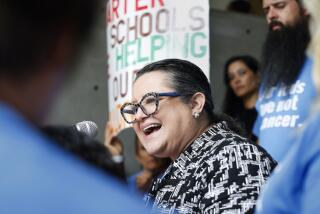Tracking system glitches affected special needs students, report says
Problems with the Los Angeles Unified School District’s new student tracking system led to widespread difficulties in identifying special needs students and placing them in the right programs, according to a court-appointed monitor’s report released Monday.
A survey of 201 schools using the new software revealed that more than 80% had trouble identifying students with special needs and more than two-thirds had difficulty placing students in the right programs, the monitor found.
Schools also had trouble scheduling other students using the system, but the monitor’s report focused on students with disabilities. About 82,000 of the district’s more than 650,000 students have disabilities that qualify them for special education.
LAUSD was mandated to create the comprehensive system — which is supposed to document students’ attendance, grades, health and disciplinary issues — as a result of a federal lawsuit in the 1990s that alleged the district violated special education students’ rights, in part by keeping disorganized records. The effort has stumbled multiple times along the way.
The district launched My Integrated Student Information System, or MISIS, at the beginning of the school year. It was met by an outcry from teachers and school staff who said major glitches prevented them from entering grades and attendance or even figuring out which students were supposed to be in their classes.
The report by independent monitor David Rostetter, who oversees the implementation of the reforms stemming from the federal lawsuit, noted that there were problems with “data integration” between MISIS and other district data systems, including the one that tracks special education students. The problems “resulted in inaccurate data in both systems, where students would show up on one system and not the other,” the monitor found.
Samuel Gilstrap, a spokesman for Los Angeles Unified, said the district takes the findings “very seriously” and is developing a formal response outlining “strategies to address areas for improvement.”
Rostetter also faulted the district for “lack of transparency” in initially downplaying problems with the new system, including in an Aug. 15 news release that said the program’s “glitches have affected less than 1% of students overall.” Gilstrap said that figure was an estimate of students who were not correctly enrolled when school started.
The monitor wrote that his office’s findings “validate the concerns and impact on schools reported by the school personnel, professional organizations and as reported by the media during the beginning of this school year” and “contradict the District’s assertions that the majority of problems with MISIS had been resolved.”
The report, in part, blamed inadequate training for the problems with the system’s rollout. Rostetter said in an interview that he thought the problems came more from the way the system was implemented than from the software itself.
“Our conclusion is that this is fundamentally an organizational management problem, not a technical problem,” he said.
The report also cited ongoing problems with making school sites physically accessible to students with disabilities but noted that the district had made strides in other required reforms for serving those with special needs, including integrating students with disabilities into the general student population and increasing the percentage of special education teachers who are fully credentialed.
“I think it’s important to highlight that the district works hard, notwithstanding mistakes and challenges,” Rostetter said.
More to Read
Start your day right
Sign up for Essential California for news, features and recommendations from the L.A. Times and beyond in your inbox six days a week.
You may occasionally receive promotional content from the Los Angeles Times.







